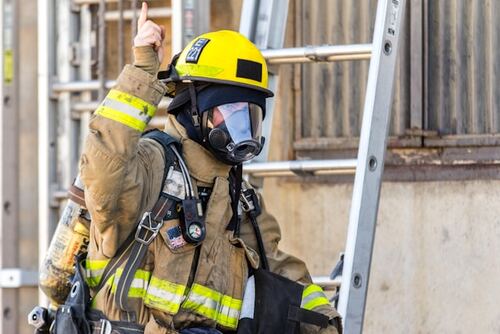A fire can quickly destroy a property when left unchecked, disruption lives and businesses in ways that can take years to recover from. The safety of a building’s occupants and the protection of assets depend on more than just luck, too, and it’s why having a robust fire safety system in place is so important.
Whether you’re managing a commercial space, designing a new build, or upgrading an existing structure, fire safety systems aren’t optional. They’re a legal requirement and a moral responsibility. From detection to suppression, every component plays a critical role in preventing disaster and ensuring compliance with UK safety standards.
Importance Of Building Fire Safety Systems
Any passive fire protection company will tell you the importance of safety systems, and how they play a vital role in safeguarding lives and property, serving as your first line of defence against potentially devastating events. These systems do more than respond to fires; they aim to detect, contain, and assist in extinguishing them swiftly. Without effective measures, you risk significant damage, costly repairs, and possibly legal penalties.
Having a well-integrated system means reducing the likelihood of harm. Alarm systems, for instance, alert occupants within moments, buying crucial time for evacuation. Fire suppression systems, such as sprinklers or gas-based controls, actively work to contain flames before they spread further. You’ll find that proper ventilation systems reduce toxic smoke circulation, enhancing safety conditions.
Failing to consider a multi-layered approach can lead to system gaps. Passive elements like fire-resistant walls and floors play a silent yet critical part in containment. Emergency exits and signage provide the necessary guidance when seconds count. Inclusion of fire safety training ensures that your occupants understand how to react during high-stress situations.
You might wonder why regulatory compliance is stressed so extensively. Beyond the legal mandates, adhering to standards like the Regulatory Reform (Fire Safety) Order 2005 ensures that your building meets safety benchmarks while minimising liability. You safeguard your occupants and maintain your reputation when proactive safety measures are in place.
Consistent maintenance is equally indispensable. Fire alarms or extinguishers that fail during emergencies pose heightened risks. Regular inspections, system updates, and staff drills keep your approach effective and reliable. Through preparedness, you instil confidence among everyone who enters your building.
In the case that your building accommodates vulnerable individuals, like residents in care homes or hospital patients, customised fire safety measures become essential. Tailoring systems ensures protection for those unable to evacuate swiftly.
Do your existing measures account for all these components, or are gaps compromising safety? Proactive steps today reduce peril later, making robust fire safety systems an investment you cannot overlook.
Key Components Of Building Fire Safety Systems
Effective building fire safety systems involve interconnected elements working to detect, contain, and combat fires while ensuring safe evacuation. Here’s what you should know about their core components.
Fire Detection Systems
Fire detection triggers the first response in an emergency. You will find systems like smoke detectors, heat sensors, and manual call points designed to identify potential hazards quickly. Smoke detectors monitor particles in the air, while heat sensors detect temperature spikes. In case of false alarms, manual call points allow you or occupants to confirm a fire manually. Advanced detection systems often integrate with alarms to prompt immediate alerts for evacuation.
Fire Suppression Systems
When a fire begins, suppression systems act to control or extinguish flames. Examples include sprinklers, gaseous systems, and dry chemical agents. Sprinkler systems spray water over flames, while gaseous systems like inert gases starve fires of oxygen to halt combustion. In areas with sensitive equipment, chemical agents can minimise damage. If these systems malfunction, fire could spread rapidly, increasing risks to people and property.
Emergency Exits And Evacuation Plans
Escape routes and evacuation plans guide safe departures during fires. Emergency exits, clearly indicated with illuminated signage, must remain unobstructed at all times. Evacuation plans ensure clarity by outlining routes, gathering points, and procedures for special requirements, such as assisting disabled individuals. Without proper planning, confusion can lead to bottlenecks and delays, endangering lives during critical moments.
Latest Advancements In Fire Safety Technology
New innovations are transforming how you protect lives and properties from fire risks. These advancements enhance detection speed, suppression accuracy, and operational efficiency.
Smart Fire Detection Systems
Advanced systems now integrate artificial intelligence to boost fire detection. AI-enabled sensors analyse data patterns to identify threats faster, even in complex environments. Instead of relying solely on basic alarm triggers, multi-criteria detectors combine smoke, heat, and gas analysis for precise alerts. You might encounter systems capable of distinguishing cooking smoke from a genuine fire to prevent unnecessary disruptions. Wireless connectivity allows you to monitor fire conditions remotely, ensuring quick responses wherever you are. By integrating this technology, your building achieves smarter, more adaptable safety measures.
Automated Fire Suppression Solutions
Fire suppression systems now operate more seamlessly through automation. Modern sprinklers use targeted water dispersion based on localised heat detection, limiting property damage while suppressing fires effectively. Gas-based systems release agents like inert or chemical gases to extinguish flames without harming sensitive electronics. You will find systems that constantly adjust extinguishing rates to avoid waste while maintaining protection. In industries involving unique hazards, foam suppression systems can neutralise fuel-fed fires with precision. These advanced systems work tirelessly, minimising human intervention and enhancing fire response reliability.
Common Challenges In Implementing Fire Safety Systems
Establishing fire safety systems presents obstacles that require careful navigation. From financial constraints to regulatory demands, challenges often surface when addressing essential components.
Cost And Maintenance
Financial investment in fire safety systems poses a significant challenge. Installation involves advanced technology, such as multi-criteria detectors or high-precision sprinklers, which might elevate initial costs. Yet, maintenance plays an equally demanding role. Maintaining these systems requires trained professionals to regularly test smoke alarms, inspect sprinklers, and verify fire suppression units. You might encounter difficulty budgeting for ongoing costs, especially in large or older buildings. Neglecting maintenance can lead to system failures, creating vulnerability during emergencies.
Compliance With Regulations
Regulatory demands can complicate the implementation process. UK fire safety legislation, including the Regulatory Reform (Fire Safety) Order 2005, outlines strict requirements for fire risk assessments and system installation. If your systems fail to meet these standards, legal penalties might follow. Adapting legacy buildings to comply presents additional hurdles due to structural limitations. You will find that achieving full compliance involves figuring inspections, documentation, and technical upgrades, all of which demand attention to detail while integrating fire safety solutions effectively.
Best Practices For Ensuring Fire Safety
Creating and maintaining a robust fire safety setup involves strategic measures that protect both lives and property. You will find that consistent efforts in multiple areas strengthen your overall fire preparedness.
Regular Inspections
Regularly checking fire safety components ensures reliability during emergencies. You might inspect alarms, sprinklers, smoke detectors, and fire extinguishers for operability. Inadequate checks risk unnoticed malfunctions. Review fire doors to confirm they close properly, with seals intact. Electrical systems may merit periodic evaluations since faults like circuit overloads can trigger fires. Keeping an updated log of inspections helps track maintenance and flag recurring issues. These assessments can also help you meet applicable UK fire safety regulations.
Employee Training Programs
Employees equipped with fire response knowledge significantly improve safety readiness. Training should introduce emergency procedures, including evacuation plans and extinguisher use. Address specific workplace hazards, as these risks might vary by industry. Regular drills test preparedness and highlight potential response gaps among staff. You might conduct scenario-based reviews to enhance decision-making under pressure. Ensure training incorporates clear communication protocols, since quick coordination mitigates chaos. Skilled teams can effectively manage an emergency, limiting risks and ensuring adherence to safety protocols.
To Conclude
Building fire safety systems is about more than meeting legal requirements; it’s about creating a secure environment for everyone who enters your premises. By prioritising well-designed, integrated solutions and staying committed to regular maintenance, you can significantly reduce risks and enhance safety.
Investing in advanced technologies and fostering a culture of preparedness ensures you’re not only protecting assets but also lives. Fire safety is a responsibility that demands proactive measures and ongoing attention, making it an essential aspect of any building’s management strategy.




